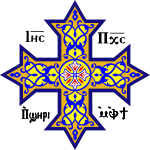- Monastery of the Martyrs
-
The Monastery of Saint Ammonius, also known as the Monastery of the Martyrs, is a Coptic Orthodox monastery located on the desert ridge, about 6 Km northeast of the city of Akhmim in Sohag Governorate, and about 7 Km south of the Temple of Khnum at Esna. It is situated about 1 Km off the road that connects Esna and Edfu, on an elevation at the edge of the desert.
The region where the Monastery of the Martyrs is located also comprises two other Coptic Orthodox monasteries. The northern monastery, located near El-Salamuni, is dedicated to the Archangel Michael. The southern one is dedicated to the Virgin Mary. The Monastery of the Martyrs is located in a central position between the two.
In 1740, Richard Pococke mentioned that the monastery was inhabited by various monks. However, a short time later it was reported that only one priest lived in the monastery.
Contents
Architecture
The Monastery of the Martyrs is enclosed by a 3-meter wall, built of mud-bricks. Upon entry through the western gate, there is an extensive outer courtyard with 24 tombs belonging to notable citizens of ancient Akhmim. The inner court is separated from the outer court by another mud-brick wall. A passage leads from the inner court to the church. This church is actually composed of two different churches connected to each other.
The southern of the two churches is the older one, dating to about the 11th or 12th century. It has a naos that consists of a nave divided into two square spaces, each of which is covered by cupolas. There are two small side aisles that serve as ambulatories, a choir and a sanctuary with two adjacent rooms. The north room serves as a baptistery.
The northern of the two churches was built soon after the southern church. It has two aisles, a choir and two sanctuaries. Apparently, at a later date, three additional sanctuaries were added to the south side of the churches, and one on the north.
Interestingly, instead of the traditional iconostasis that usually separates the sanctuary from the nave in traditional Coptic churches, the two churches in the Monastery of the Martyrs comprise simple little columns separated by small doors and windows, which fulfill the function of iconostasis in other churches.
The three original, central sanctuaries of the two churches are dedicated to the Holy Virgin Mary. Some believe, however, that the south sanctuary was dedicated to Saint Gregory of Nazianzus, the central one was dedicated to the Holy Martyrs, and the northern one was dedicated to the Archangel Michael. Only the central sanctuary has a wooden ciborium, which consists of a freestanding vaulted canopy supported by columns.
The sanctuaries and choirs of the two churches are decorated with fine wall paintings, though in rather bad condition. Many of these are as old as the two churches.
In the southern sanctuary, Christ is represented between the Archangels Michael and Gabriel, and two saints who are probably Saint Basil and Saint Gregory of Nazianzus.
The walls of the sanctuary of the Martyrs (center) are adorned with several paintings of Coptic crosses with the shroud. In the lower part of the sanctuary are depictions with the image of the Holy Virgin Mary enthroned between the Archangels Michael and Gabriel.
The concha (a semidome) of the apse has an image of Christ Pantocrator surrounded by the apocalyptic symbols of the Evangelists, consisting of an ox, a lion, a human being, and an eagle. Saint Peter and Saint Stephen are presented on the arch that divides the choir from this sanctuary. The screen of the sanctuary dedicated to the Martyrs has an inlaid Coptic text dating to the 18th or 19th Century, which reads "Be greeted church, thou mansion of angels."
The northern sanctuary also contains the iconography of Christ Pantocrator and the Archangels. Two warrior saints on horseback are portrayed in the choir of the north church, namely Saint Theodore to the north and Saint Claudius to the south.
The Necropolis
The Monastery of the Martyrs is built within a large necropolis. This necropolis provided a large quantity of Coptic textiles, which are exhibited today in various museums and art-collections in Europe and America. Among these are the famous 8th/9th century orbiculi with the history of the Biblical figure Joseph. While the oldest building within the monastery today dates back to the second half of the eleventh century, many funerary stelae with Greek inscriptions attest to the more ancient age of the monastic complex.
The Book of Proverbs
In 1904, the Book of Proverbs was found in the Monastery of the Martyrs. It is one of the earliest complete papyrus manuscripts in existence. It contains a translation of the Book of Proverbs into the Akhmimic dialect of Coptic. It was probably written in the 4th century, and is one of the longest texts in this dialect ever preserved.
See also
- Coptic Orthodox Church
- Coptic monasticism
References
- 2000 Years of Coptic Christianity. By Meinardus, Otto F. A. 1999. American University in Cairo Press. ISBN 977 424 5113.
- Christian Egypt: Coptic Art and Monuments Through Two Millennia. By Capuani, Massimo. 1999. Liturgical Press. ISBN 0-8146-2406-5.
- Churches and Monasteries of Egypt and Some Neigbouring Countries. By Abu Salih the Armenian. Edited and Translated by Evetts, B.T.A. 2001. Gorgias Press. ISBN 0-9715986-7-3.
External Links
Upper Egypt: Monastery of Saint Epiphanius · Monastery of Saint Fana · Monastery of the Martyrs · Monastery of Saint Matthew the Potter · Red Monastery · White Monastery
Middle Egypt: Monastery of Saint ParsomaLower Egypt: Eastern Desert: Scetes: Monastery of Saint Macarius the Great · Monastery of Saint Pishoy · Paromeos Monastery · Syrian MonasterySinai: Category – Christianity in Egypt – Monasteries by country Categories:- Christian monasteries in Egypt
- Coptic Orthodox monasteries
Wikimedia Foundation. 2010.
